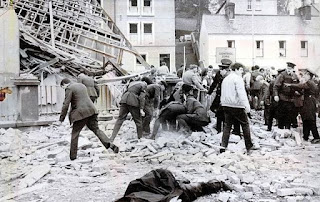Whilst most people enjoyed end of year festivities, Jack McDade spent time after Christmas 1971, in his garage north of Dublin, blending a fertilizer based homemade bomb. This experimental mix known within the Provisional IRA as "the black stuff", had chemical properties that brought an end to McDade's war against the British. When the shovel he was using to blend the explosives, made contact with the garage floor and produced a spark, PIRA lost it's Quartermaster General in the blast, but gained a deadly new strategy that would bedevil Northern Ireland for the remaining decades of the troubles in Northern Ireland.
PIRA's Belfast Brigade had received a large shipment of McDade's black stuff, prior to his demise. When they were warned about the dangers in handling the explosives, they opted to dispose of it by putting it inside a car and detonating it in downtown Belfast. The evolutionary turning point that occurred as a result of Jack McDade's premature death, was that PIRA had devised a tactic for delivering large amounts of explosives to targets. This was the birth of the PIRA car bomb.
Further development of the black stuff, over the space of several weeks, made it safer to handle. This meant that PIRA now had a virtually unlimited amount of explosives and was no longer dependent solely on gelignite, the supply of which was being interrupted by British and Irish authorities.
With this significant logistical advance in early 1972 enabling the manufacture of much larger bombs and huge landmines for rural areas, PIRA was able to escalate the level of violence, but the unsurprising cost of frequently detonating large bombs in public places, was the carnage visited upon the civilian population.
Civilian casualties of PIRA terrorist attacks would be a recurring theme throughout the troubles, with the atrocities usually accompanied by excuses and lies, as PIRA tried to shift blame onto others. Sometimes civilian casualties were an unintended consequence of their terrorist activities, but an objective consideration of their track record, leads to an unavoidable conclusion, PIRA not only accepted the likelihood of maiming or killing civilians in attacks, their injuries and fatalities were often deliberate and a means to an end.
Behind the PIRA propaganda narrative that they did not deliberately target civilians, the cold blooded reality is that they, as with Loyalist terrorist groups, had a strategy of terror against the civilian populace, which was primarily, but not exclusively, sectarian in nature. This willingness by PIRA, to not only endanger but to actually target civilians, would become apparent early on in the troubles. To observe this decades long terror strategy in action, there are events in 1972, probably the deadliest year of the troubles, that expose it's full horror.
1972 was a pivotal year in the bloody history of the Northern Ireland troubles. Some of the events and key actors in the early productions of this theatre of terrorism, will be the subject of following blogs.
Civilian casualties of PIRA terrorist attacks would be a recurring theme throughout the troubles, with the atrocities usually accompanied by excuses and lies, as PIRA tried to shift blame onto others. Sometimes civilian casualties were an unintended consequence of their terrorist activities, but an objective consideration of their track record, leads to an unavoidable conclusion, PIRA not only accepted the likelihood of maiming or killing civilians in attacks, their injuries and fatalities were often deliberate and a means to an end.
Behind the PIRA propaganda narrative that they did not deliberately target civilians, the cold blooded reality is that they, as with Loyalist terrorist groups, had a strategy of terror against the civilian populace, which was primarily, but not exclusively, sectarian in nature. This willingness by PIRA, to not only endanger but to actually target civilians, would become apparent early on in the troubles. To observe this decades long terror strategy in action, there are events in 1972, probably the deadliest year of the troubles, that expose it's full horror.
1972 was a pivotal year in the bloody history of the Northern Ireland troubles. Some of the events and key actors in the early productions of this theatre of terrorism, will be the subject of following blogs.
You can read my next blog here: Terrorists Terrorise





